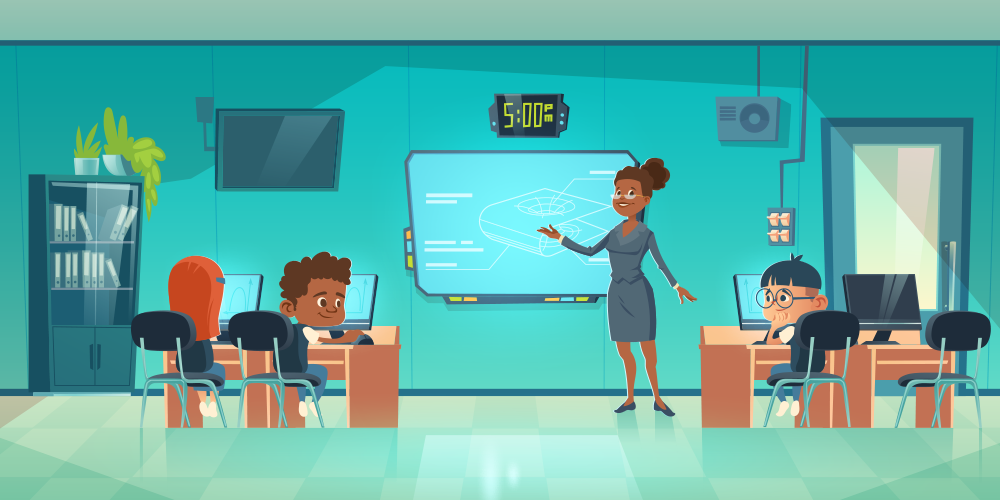How Teachers Can Use Chatgpt to Enhance Classroom Experience
- admin
- 2023-06-22
- 11 min read

Brief Overview of ChatGPT
Contents
In the age of rapidly advancing technology, artificial intelligence (AI) has become an essential part of our daily lives. One of the most impressive AI applications is ChatGPT, a language model powered by OpenAI that has the ability to understand and generate human-like text. ChatGPT has been widely used across various industries, and education is no exception. As a versatile tool, ChatGPT can be employed by educators to enhance their teaching practices and improve the overall classroom experience . In this article, we will explore the potential benefits of using ChatGPT for teachers and how it can revolutionize the educational landscape.
Potential Benefits for Teachers
Embracing ChatGPT in the classroom can unlock numerous advantages for teachers. From streamlining communication to simplifying assessment and feedback, this AI-powered tool can support educators in their quest for effective teaching methods. Some of the key benefits of incorporating ChatGPT into the educational system include:
- Enhancing Classroom Communication: ChatGPT can facilitate parent-teacher communication, encourage student participation, and promote engaging group discussions.
- Supporting Lesson Planning: Teachers can use ChatGPT to create personalized lesson plans, find innovative lesson ideas, and generate creative writing prompts for their students.
- Simplifying Assessment and Feedback: ChatGPT can assist with automated grading, provide constructive feedback on student work, and help identify areas for improvement.
- Encouraging Independent Learning: By offering study support, promoting critical thinking, and aiding in research and exploration, ChatGPT can foster a culture of self-directed learning among students.
As we delve deeper into these benefits, it becomes apparent that ChatGPT can be an invaluable resource for teachers striving to create a dynamic and engaging learning environment . In the following sections, we will examine each of these aspects in detail and provide tips for implementing ChatGPT in the classroom to ensure a seamless integration of this AI technology.
Enhancing Classroom Communication
Effective communication is a crucial aspect of a thriving educational environment. By incorporating ChatGPT into the classroom, teachers can streamline various aspects of communication, encourage student participation, and facilitate group discussions.
Streamlining Parent-Teacher Communication
Parent-teacher communication plays a vital role in a child’s academic success. ChatGPT can significantly improve this by creating an efficient communication channel between educators and guardians. Teachers can use the AI to draft newsletters, update parents on their child’s progress, and address concerns in a timely manner. Additionally, ChatGPT can assist in generating personalized messages, ensuring that each parent receives relevant information about their child’s academic journey.
Encouraging Student Participation
Engaging students in class discussions and activities is essential for their intellectual growth. ChatGPT can boost participation by generating thought-provoking questions and prompts, tailored to the subject matter at hand. By incorporating AI-generated content, teachers can foster an inclusive learning environment that caters to diverse learning styles and encourages all students to contribute their thoughts and ideas.
Facilitating Group Discussions
Group discussions are an excellent way for students to develop critical thinking skills, collaborate, and learn from their peers. ChatGPT can assist in orchestrating these discussions by providing teachers with engaging topics, guiding questions, and conversation starters. Furthermore, the AI can help educators monitor the flow of discussions, ensuring that all students have the opportunity to voice their opinions and participate actively.
By embracing ChatGPT as a communication tool, teachers can create a dynamic and inclusive environment that fosters growth, collaboration, and learning. With the support of this innovative AI technology, educators can focus on their most important task – nurturing the curious and creative minds of their students.
Supporting Lesson Planning
Incorporating ChatGPT into the planning process can significantly help teachers create engaging and tailored lessons for their students. By streamlining the development of personalized lesson plans, generating innovative ideas and resources, and providing writing prompts, this AI tool can be a valuable aid for educators.
Creating Personalized Lesson Plans
One of the most significant challenges for teachers is designing lesson plans that cater to the diverse learning needs and styles of their students. ChatGPT can play a crucial part in this process by assisting educators in crafting personalized lesson plans based on individual student profiles. Teachers can input student information, such as learning styles, strengths, and weaknesses, into the AI system. ChatGPT then generates customized lesson plans that take into account each student’s unique needs, promoting more effective learning experiences .
Finding Lesson Ideas and Resources
Generating new ideas and discovering essential resources can be time-consuming for teachers. ChatGPT can help save valuable time by providing creative lesson ideas and recommending valuable resources based on specific subject matter and curriculum goals. For instance, a teacher looking for new ways to teach a history lesson can input relevant keywords or curriculum objectives, and ChatGPT will offer a variety of suitable lesson ideas and resources. This feature makes it easier for teachers to stay up-to-date with the latest educational materials while also reducing the time spent on lesson planning.
Generating Writing Prompts
Creative writing is a crucial aspect of education that helps students develop their critical thinking, communication, and self-expression skills. However, coming up with engaging writing prompts can sometimes be a difficult task for educators. ChatGPT can generate a wide array of writing prompts based on specific themes, genres, or subject matter, providing students with exciting and thought-provoking topics for their writing assignments. Teachers can also input specific goals or learning objectives, and ChatGPT will create prompts tailored to those requirements, further enhancing the writing experience for students.
In conclusion, ChatGPT offers significant benefits to teachers in the realm of lesson planning. By creating personalized lesson plans, providing innovative ideas and resources, and generating writing prompts, this AI tool can help educators craft engaging, effective, and tailored learning experiences for their students. As the adoption of AI in education continues to grow, teachers can leverage tools like ChatGPT in the classroom to enhance their teaching methods and better support student learning.
Simplifying Assessment and Feedback
Assessment and feedback are crucial aspects of the teaching process, enabling both educators and students to gauge progress and identify areas for improvement. By incorporating ChatGPT into the classroom, teachers can streamline these processes and provide more effective feedback to students.
Automated Grading Assistance
Utilizing ChatGPT for automated grading assistance can save teachers valuable time and effort. While it may not replace traditional grading methods entirely, AI-powered tools can help with objective assessments like multiple-choice tests and short-answer questions. Additionally, they can provide instant feedback, allowing students to quickly learn from their mistakes and adjust their understanding of the material. This not only lightens the workload for teachers but also fosters a more efficient learning environment. For more information, check out chatgpt in education .
Giving Constructive Feedback
Providing constructive feedback is essential for student growth, but it can be time-consuming for teachers to deliver personalized remarks to each pupil. With ChatGPT, educators can easily generate tailored feedback based on students’ work, focusing on both strengths and areas requiring further development. By using AI to assist in this process, teachers can ensure that their feedback is both meaningful and timely, empowering students to take charge of their learning journey.
Identifying Areas for Improvement
As part of the assessment process, it’s crucial to pinpoint areas where students may be struggling or need additional support. ChatGPT can analyze student work, highlighting common mistakes, misconceptions, or gaps in understanding. This valuable insight allows teachers to adjust their teaching strategies to better address students’ needs and provide targeted interventions. To further explore the potential of ChatGPT in the classroom, visit chatgpt for teachers .
In summary, integrating ChatGPT into the assessment and feedback process can significantly simplify these tasks for teachers while providing students with more effective, personalized support. By embracing AI technology in the classroom, educators can optimize their time and resources, ensuring that each student receives the attention and guidance they need to succeed.
Encouraging Independent Learning
One of the most valuable skills a student can develop is the ability to learn independently. By incorporating ChatGPT into the classroom, teachers can support this skill development and empower students to take charge of their education. This section will explore how ChatGPT can provide study support, encourage critical thinking, and facilitate research and exploration.
Providing Study Support to Students
ChatGPT can serve as an accessible and responsive study aid for students, offering assistance with a wide range of subjects. When students encounter difficulties with their assignments or need clarification on a topic, they can turn to ChatGPT for guidance. The AI can help explain complex concepts, provide examples, and offer additional resources for further learning. This on-demand support can help students better retain information and build confidence in their abilities. Read more about chatgpt for students for a detailed overview of its benefits.
Encouraging Critical Thinking
Critical thinking is a crucial skill that students should develop throughout their education. ChatGPT can be utilized to stimulate thought-provoking discussions and challenge students to analyze information from multiple perspectives. Teachers can use the AI to generate open-ended questions, debate topics, or even hypothetical scenarios, encouraging students to think critically and respond creatively. By engaging in these interactive activities, students can hone their analytical and problem-solving skills while also developing a deeper understanding of the subject matter.
Facilitating Research and Exploration
Inquiry-based learning is an effective way to foster students’ curiosity and promote independent exploration. ChatGPT can serve as a valuable research assistant, helping students find relevant information, resources, and ideas to support their projects or assignments. By offering real-time support and diverse insights, ChatGPT enables students to delve deeper into their chosen topics, expanding their knowledge and understanding. Furthermore, the AI can aid in the development of research skills by guiding students through the process of forming research questions, evaluating sources, and organizing their findings.
In conclusion, ChatGPT has the potential to significantly enhance independent learning by providing study support , encouraging critical thinking, and facilitating research and exploration. By incorporating this innovative AI technology into the classroom, teachers can empower students to take charge of their education and develop essential skills for lifelong learning. Discover more about chatgpt in education to explore its various applications and benefits.
Tips for Implementing ChatGPT in the Classroom
As you embark on your journey to integrate ChatGPT into your classroom, it is crucial to take a strategic approach. This section offers pertinent guidance on selecting the right GPT tool, integrating ChatGPT into your existing curriculum, and ensuring student privacy and safety.
Selecting the Right GPT Tool
There are numerous GPT tools available, but not all of them are suitable for classroom use. To choose the most appropriate one, consider the following factors:
- Ease of use: Opt for a tool that is user-friendly and straightforward, both for you and your students.
- Features: Ensure that the tool offers features that align with your teaching objectives, such as lesson planning assistance, assessment support, and student engagement tools.
- Affordability: Choose a tool that fits within your budget constraints while still providing the necessary features.
Taking these factors into account will help you find the perfect GPT tool to enhance your classroom experience. For more information on available options, refer to our article on chatgpt for teachers.
Integrating ChatGPT Into Existing Curriculum
To make the most of ChatGPT, it’s essential to integrate it seamlessly into your current curriculum. Here are a few steps to help you achieve this:
- Identify the areas of your curriculum that could benefit from ChatGPT support: Pinpoint specific aspects of your curriculum where ChatGPT could offer valuable assistance, like lesson planning, student communication, or assessment.
- Start small: Introduce ChatGPT incrementally, focusing on one area at a time. This will allow you and your students to gradually adapt to the new technology.
- Monitor progress and gather feedback: Regularly assess the impact of ChatGPT on your teaching and your students’ learning. Solicit feedback from students and colleagues to make necessary adjustments along the way.
By following these steps, you can ensure a smooth transition to incorporating ChatGPT in your classroom.
Ensuring Student Privacy and Safety
As with any technology, it’s essential to prioritize student privacy and safety when implementing ChatGPT in your classroom. Here are some ways to achieve this:
- Understand data storage policies: Familiarize yourself with the GPT tool’s data storage and privacy policies to ensure that your students’ personal information remains secure.
- Educate students on responsible use: Teach students about appropriate online behavior, including the importance of not sharing personal information and maintaining respectful communication.
- Monitor student interactions: Keep an eye on how students interact with ChatGPT to ensure they are using the technology responsibly and safely.
By taking these precautions, you can confidently implement ChatGPT in your classroom without compromising student privacy and safety.
In conclusion, integrating ChatGPT into your teaching practices can offer numerous benefits, including enhanced communication, lesson planning support, and simplified assessment. By selecting the right GPT tool, integrating it into your existing curriculum, and prioritizing student privacy and safety, you can maximize the potential of this innovative technology to elevate your classroom experience. For more ideas on how to use ChatGPT in education, check out our article on chatgpt in the classroom.
Conclusion
Embracing AI Technology in Education
As we move forward in the age of digital transformation, it’s essential for educators to embrace the potential of AI technologies, such as ChatGPT, to enhance the classroom experience. By integrating these tools into their teaching practices, educators can optimize communication, streamline lesson planning, simplify assessment and feedback, and encourage independent learning.
AI-powered tools like ChatGPT have the power to revolutionize the way teachers and students interact with educational content, while also fostering critical thinking and problem-solving skills. When we welcome these advancements into our educational institutions, we create a more dynamic and engaging learning environment that caters to the diverse needs of students.
Continuing to Explore ChatGPT for Teachers
The applications of ChatGPT for teachers are vast and continually evolving. As educators, it’s important to stay informed about the latest developments in AI technology and its potential impact on education. By doing so, they can continue to refine their use of ChatGPT in the classroom and discover new ways to leverage its capabilities to support and enhance their teaching practices.
Moreover, educators should collaborate with their peers and share their experiences and insights about using ChatGPT in their respective classrooms. This way, they can learn from one another and contribute to the growing body of knowledge on how to effectively integrate AI-powered tools into the educational landscape.
In conclusion, the adoption of ChatGPT and other AI technologies marks a promising step forward for the future of education . By embracing these advancements and continuing to explore their potential, educators can create more engaging, personalized, and empowering learning experiences for their students.
21K School
Read our latest education blogs here. We are pioneers in proffering personalised, affordable and high-quality lessons using an advanced learning platform.


Join Asia’s Leading Online School and Unlock
endless opportunities
Join Asia’s
Leading Online School
and Unlock endless opportunities

 Thailand
Thailand




